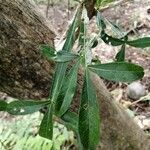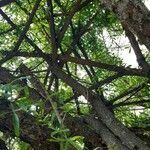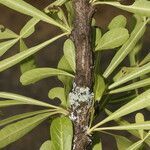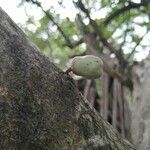Small tree to 25 cm d.b.h. and 6 m tall, the branches crooked, the crown open; branchlets essentially lacking, the smaller branches thick, subterete, with alternate condensed, short-shoot projections each bearing a fascicle of leaves from its center. Leaves both compound and simple from each fascicle, the com-pound leaves 3-foliolate with sessile oblanceolate leaflets 1.0-4.5 cm long and 0.3-1.2 cm wide, round-tipped or slightly emarginate, lepidote but otherwise glabrous, rigid-chartaceous, the petiole winged, 2.7-11.5 cm long and 3-15 mm wide, lepidote, oblanceolate, rigid chartaceous as the leaflets, the simple leaves much smaller, 1.9-3.2 cm long and 0.5-1.0 cm wide, similar to single leaflets or petioles of compound leaves. Inflorescence one or 2 cauliflorous flowers borne on larger branches or trunk, pedicels lepidote, 0.5-0.8 cm long. Flowers with a musky odor, calyx split nearly to the base into two subequal lobes, each 1.4-1.9 cm long and 0.7-1.4 cm wide, mostly glabrous, slightly lepidote at the base, usually with sunken plate-shaped glands; corolla off-white, tubular-campanulate with a horizontal pleat midway across the lower side of throat, fleshy, 4.0-6.5 cm long and 1.8-2.5 cm wide at the mouth of tube, the tube 2.8-4.2 cm long, the lobes 1-1.5 cm long, more or less triangular and fused at the bases, mostly glabrous, sparsely glandular-lepidote outside; stamens subexserted, the anther thecae ca. 2 mm thick, only partially divergent, 5-7 mm long, the anterior filaments 2.1-3.4 cm long, inserted 0.8-1.7 cm from the base of the tube, the posterior filaments 2.3-3.8 cm long, inserted 1.1-1.5 cm from the base of tube, the staminode 3-4 mm long, inserted 0.9-1.0 cm from the base of the tube; pistil 4.3-5.8 cm long, the ovary rounded-conical, lepidote, 5-6 mm long and 4-5 mm wide, the ovules multi-seriate on 4 parietal placentae; disc pulvinate, 2-3 mm long and 0.9-1.4 mm wide. Fruit a pepo or calabash, more or less spherical, 7-10 cm in diameter; seeds small, thin, wingless, 6-7 mm long and 7-9 mm wide, scattered through the pulp of the fruit.
More
A tree. It grows 8 m tall. It has drooping branches but no small branches. The leaves are 8-15 cm long. They have 3 leaflets. The leaves are cross shaped. They line the main branch. The leaf stalks have wings. The flowers emerge directly from the main trunk. They are brown with yellow throats. The flowers are bell shaped. The fruit is round and green and gourd-like. The fruit are 10 cm long.
A crooked tree, 5-14 m, to 25 cm Ø. Leaves in scattered fascicles on the twigs, with a winged petiole, 2½-H cm; leaflets brittle, lanceolate-obspathulate, sessile, 1-4½ cm. Flowers 1-2 rami-and cauliflorous; calyx 2-lobed to the base; corolla brownish with brown-purple venation, rank-scented, with a transversal fold, 4-6 cm. Fruit with a hard shell, ± globular, 5-10 cm Ø.
It suits a tropical climate. It needs an average, well-drained soil. It can grow in full sun or light shade. It grows in areas with an annual rainfall between 1,000-2,500 mm. In Africa it grows below 1,000 m altitude. It can grow in arid places. It suits plant hardiness zones 10-11.
More
Common or abundant on essentially dry but at seasons often very wet plains and hillsides, at elevations up to 1,200 metres.
The fruit are occasionally eaten. They are also made into a drink. The ripe seeds are ground then mixed with rice, roasted pumpkin seeds, lemon peel, sugar, water and ice and made into a non-alcoholic drink called "horchata". Caution: Alcohol is a cause of cancer. The seeds yield an edible oil.
More
Uses. The pulp is in Mexico sometimes used as a medicine; the shells are less in demand than those of Crescentia cujete, but used for the same purposes. No fruits seen from Malesia.





